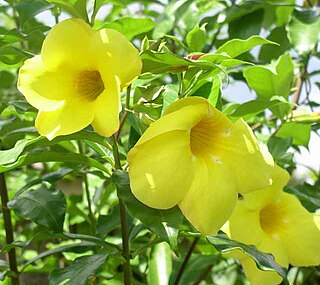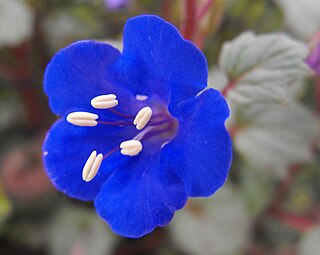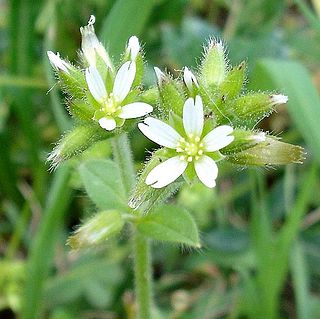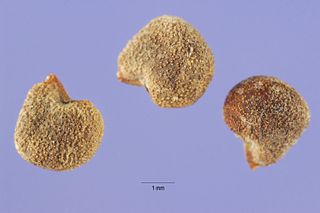
Allamanda is a genus of flowering plants in the family Apocynaceae. They are native to the Americas, where they are distributed from Mexico to Argentina. Some species are familiar as ornamental plants cultivated for their large, colorful flowers. Most species produce yellow flowers; A. blanchetii bears pink. The genus name Allamanda honors the Swiss botanist and physician Frédéric-Louis Allamand (1736–1809). It also is official flower of Kuching North City Hall.

Capsicum annuum is a species of the plant genus Capsicum native to southern North America and northern South America. This species is the most common and extensively cultivated of the five domesticated capsicums. The species encompasses a wide variety of shapes and sizes of peppers, both mild and hot, such as bell peppers, jalapeños, New Mexico chile, and cayenne peppers. Cultivars descended from the wild American bird pepper are still found in warmer regions of the Americas. In the past, some woody forms of this species have been called C. frutescens, but the features that were used to distinguish those forms appear in many populations of C. annuum and are not consistently recognizable features in C. frutescens species.

Campanula americana, the American bellflower, is a tall bellflower native to eastern North America from the Great Lakes region south to Florida and from the Dakotas east to New York. This native plant is an annual or biennial from 2-6' tall. Some authorities, including the USDA PLANTS database, consider the name Campanulastrum americanum to be the accepted name for this species.

Abutilon pictum, syn. Abutilon striatum,(disputed), is a species of flowering plant in the family Malvaceae. It is native to southern Brazil, Argentina, Paraguay and Uruguay. The plant has become naturalised in Central America, and is used in horticulture. Common names include redvein abutilon, red vein Indian mallow, redvein flowering maple, Chinese-lantern and red vein Chinese lanterns.

Hibiscus laevis, the halberd-leaf rosemallow, is a herbaceous perennial flower native to central and eastern North America. Their showy, creamy-white or pink flowers are large, up to 6 inches (15 cm) across, and are hard to miss. These flowers require exposure to sunlight to open up properly, and then last only a single day.

The smooth hawksbeard, Crepis capillaris, is a species of flowering plant in the dandelion tribe within the sunflower family, native to Europe. It has become naturalized in other lands and is regarded as a weed in some places.

Moluccella is a genus of annual and short-lived perennial plants native to Central + southwestern Asia and the Mediterranean. They are tall, upright, branched plants to 1 meter or more with toothed leaves and small white fragrant flowers.
- Moluccella aucheri(Boiss.) Scheen - Iran, Pakistan
- Moluccella bucharica(B.Fedtsch.) Ryding - Tajikistan
- Moluccella fedtschenkoana(Kudr.) Ryding - Tajikistan
- Moluccella laevisL. - Bells of Ireland - Turkmenistan, Iran, Iraq, Caucasus, Cyprus, Syria, Lebanon, Palestine, Turkey; naturalized in scattered locations in Europe, Africa, and North America
- Moluccella olgae(Regel) Ryding - Tajikistan, Kyrgyzstan
- Moluccella otostegioidesPrain - Pakistan
- Moluccella sogdiana(Kudr.) Ryding - Tajikistan
- Moluccella spinosaL. - Mediterranean from Spain + Algeria to Turkey + Palestine

Phacelia campanularia is a species of flowering plant in the borage family, Boraginaceae, known by the common names desertbells, desert bluebells, California-bluebell, desert scorpionweed, and desert Canterbury bells. Its true native range is within the borders of California, in the Mojave and Sonoran Deserts, but it is commonly cultivated as an ornamental plant and it can be found growing elsewhere as an introduced species.

Opuntia engelmannii is a prickly pear common across the south-central and Southwestern United States and northern Mexico. It goes by a variety of common names, including desert prickly pear, discus prickly pear, Engelmann's prickly pear in the US, and nopal, abrojo, joconostle, and vela de coyote in Mexico.

Tecoma stans is a species of flowering perennial shrub in the trumpet vine family, Bignoniaceae, that is native to the Americas. Common names include yellow trumpetbush, yellow bells, yellow elder, ginger-thomas. Tecoma stans is the official flower of the United States Virgin Islands and the floral emblem of The Bahamas.

Symphyotrichum laeve is a flowering plant native to Canada and the United States. It has the common names of smooth blue aster, smooth aster, smooth-leaved aster, glaucous Michaelmas-daisy and glaucous aster.

Cerastium glomeratum is a species of flowering plant in the family Caryophyllaceae known by the common names sticky mouse-ear chickweed and clammy chickweed. It is probably native to Eurasia but it is known on most continents as an introduced species. It grows in many types of habitat. The blooming period is February, March, April, and May.

Anoda cristata is a species of flowering plant in the mallow family known by many common names, including spurred anoda, crested anoda, and violettas. Its exact native range is unclear but it probably spans Mexico and part or all of Central America. It is known throughout the rest of the Americas as well as Australia as an introduced species and often a noxious weed. This is an annual herb reaching a maximum erect height between one half and one meter. The stem is ridged and branching. The plant is variable in morphology, especially in leaf shape, but leaves are usually somewhat triangular, and hairy. Solitary flowers grow in the leaf axils. The flower is 2 to 3 centimeters wide, with pointed green to reddish sepals and lavender petals. The fruit is a bristly, disc-shaped capsule with 9 to 20 segments. Each segment produces a seed. This is sometimes an agricultural weed, especially of soybeans. It is tolerated as a weed of crop fields in parts of Mexico, and even fostered, because it is eaten and used as a source of medicinal remedies.

Atriplex rosea is a species of saltbush known by the common names tumbling saltbush, red orach, redscale and tumbling orach. It is native to Eurasia but it is widespread elsewhere as an introduced species.

Bidens laevis is a species of flowering plant in the daisy family known by the common names larger bur-marigold and smooth beggarticks. It is native to South America, Mexico, and the southern and eastern United States. It grows in wetlands, including estuaries and riverbanks.

Parapholis incurva is a species of grass native to Europe, Asia and northern Africa, and widely naturalised elsewhere. Common names include coast barbgrass, curved sea hard grass, curved hard-grass, sicklegrass, curved sicklegrass and curved parapholis.

Stokesia is a monotypic genus of flowering plants in the daisy family, Asteraceae, containing the single species Stokesia laevis. Common names include Stokes' aster and stokesia. The species is native to the southeastern United States.

Scleranthus annuus is a species of flowering plant in the family Caryophyllaceae known by the common names German knotweed and annual knawel. It is native to Europe, Asia, and North Africa, and it is known throughout the rest of the temperate world as an introduced species and a common weed. It grows in many types of habitat, often in disturbed areas.

Silene gallica is a species of flowering plant in the family Caryophyllaceae known by several common names, including common catchfly, small-flowered catchfly, and windmill pink. It is native to Eurasia and North Africa, but it can be found throughout much of the temperate world as a common roadside weed.

Vicia benghalensis is a species of vetch known by the common names purple vetch and reddish tufted vetch. It is native to southern Europe, North Africa, and nearby islands, and it is utilized elsewhere in agriculture and may be present in the wild as an introduced species. It is an annual herb with a climbing stem which is coated in hairs, often densely, making the plant appear silvery white. Each leaf is made up of several pairs of elongated leaflets which measure up to 3 centimeters in length. The inflorescence is a one-side raceme of several dark reddish purple flowers. Each flower has a densely hairy calyx of sepals and a tubular corolla between one and two centimeters in length. The fruit is a flat, hairy legume pod up to 3.5 centimeters long containing multiple seeds.




















